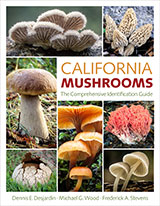The North American Species of Pholiota
34. Pholiota serotina sp. nov.
Illustrations: Text figs. 70-71.
Pileus 2-4 cm latus, hemisphericus vel late convexus, viscidus, subsquzamulosus, pallide alutaceus. Lamellae adnatae, demum sinuatae, confertae, latae, albidae demum ligno-brunneae. Stipes 4-5 cm longus, gracilis, fibrillosus, deorsum brunnescens, sursum pallidus. Vellum fibrillosum. Sporae 7.5-9 (11.5) x 4-5 (5.5) µ. Pleurocystidia inconspicua, fusoide ventricosa, 18-24 x 6-9 µ. Specimen typicum in Herb. Univ. of Mich. conservatum est; legit prope Ann Arbor, 12 Nov. 1911, C. H. Kauffman.
Pileus 2-4 cm broad, at first subhemispheric, then broadly convex, margin decurved, pinkish buff, the center minutely dotted by innate scales, later taking on pale olive color towards margin, slightly incarnate tinted on the disc from the dotlike scales, with a distinct viscid pellicle, even on margin. Context concolor, thin.
Lamellae adnate, then sinuate-uncinate, or with faint decurrent lines, medium broad (4-5 mm), close, of equal width, white at first, covered when young by a cortinate veil, at length gray-brown ("wood brown") and dusted by ferruginous spores, edges entire.
Stipe 4-5 cm long, 2-4 mm thick, slender, subequal and tapered slightly downward, at first covered with fibrillose subsilky covering, brunnescent, tubular and white within, becoming brown later. Veil cortinate, evanescent.
Spores 7.5-9 (11.5) x 4-5 (5.5) µ, smooth, apical pore distinct and in most spores surrounded by a wall thickening evident in an optical section view of the spore; shape elliptic to oblong in face view or varying to slightly irregular in outline, in profile view obscurely inequilateral to subelliptic, wall up to about 0.5 µ thick in KOH mounts, tawny in KOH and not much change in Melzer's reagent.
Basidia 18-24 x 6-8.5 µ, 2-spored and 4-spored, obese, yellowish in KOH, orange-yellowish in Melzer's reagent. Pleurocystidia 18-24 x 6-9 µ, resembling basidioles or rarely with a neck 4-5 µ diam., very inconspicuous, content as revived in KOH homogeneous, hyaline. Cheilocystidia 22-35 x 7-12 µ, fusoid-ventricose to ventricose- capitate, usually more ochraceous than the pleurocystidia, smooth, thin-walled. Caulocystidia none.
Gill trama of subparallel floccose hyphae ochraceous in KOH, with tlin smooth walls, cells 3-10 µ diam., subhymenium of narrow subgelatinous hyphae in a poorly defined layer. Pileus with a tangled layer of encrusted hyphae 4-9 µ diam., those at surface collapsing as if gelatinized (hence surface may be viscid); hypodermial region more compact and highly colored. Context hyphae poorly revived but interwoven and cells inflated. Clamp connections present. All hyphae inamyloid (merely ochraceous in Melzer's reagent).
Habit, Habitat, and Distribution: On soil, Michigan and Pennsylvania, September-November. Rare.
Observations: The distinctive feature of this species is the differentiation at the spore apex (fig. 71). It is not conspicuous, but we believe significant taxonomically. In view of the description of the pileus as viscid (by Kauffman) we are inclined to interpret the collapsing surface hyphae as producing this effect, but the anatomical basis for the viscid character is to be regarded as questionable here. The pleurocystidia are so widely scattered and inconspicuous that their presence is of little help to the taxonomist. It is a peculiar fungus which should be critically restudied from fresh material.
Material Examined: MICHIGAN: Type, Kauffman, Ann Arbor. Nov. 12, 1911; PENNSYLVANIA: collected by Kauffman.

